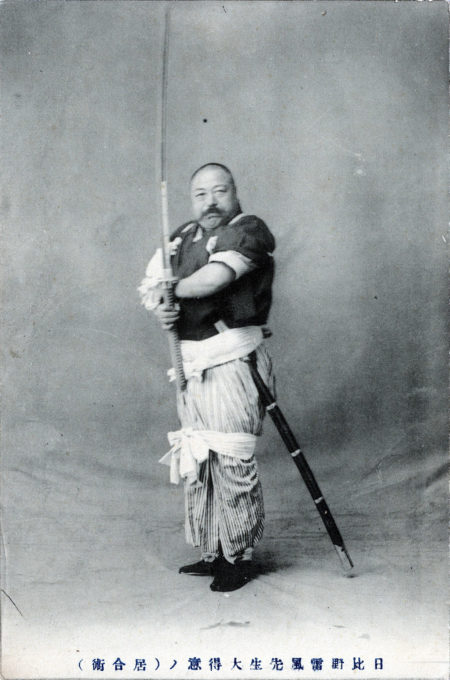
Japanese master swordsman Hibino Raifu, c. 1910. Born Hibino Masayoshi, he was an expert swordsman, and would found the Shinto ryu school of swordsmanship – an amalgamation of kenshibu (sword dancing), Zen Buddhism, and Shintoism. A testament to Hibino’s popularity was him being the subject of Japan’s first domestically-produced documentary motion picture, released in 1908.
Shinto ryu [the Shinto school of kenbu, sword dancing] embodies a broad collection of Japanese cultural art forms, including sword, traditional dance, music and poetry chanting. Born out of the tumultuous Meiji Restoration, it would ultimately boast having more than a dozen dojos and its name would be known across Japan, even by the Emperor.
The school of Shinto ryu was founded in 1890 by Hibino Raifu, who was not only an incredibly talented swordsman but was also a great thinker exposed to some of the greatest minds in Japan. It would became inexorably linked to the rise and fall of the Japanese Empire.
Hibino was born Hibino Masayoshi into a samurai family in 1864 at Inuyama Castle, in Kagoshima, where his father worked as a swordsmith. With the fall of the Tokugawa Shogunate, the family decided to move to Saitama in the hopes of finding a better life. It was there, at age six, that Hibino would begin learning sword. (He would later change his surname to ‘Raifu’, in honor of two ancient Shinto gods, Rai-Jin and Fu-Jin, whose values Hibino wished to embody.)
Advancement happened again for Hibino in 1888, when he competed in a sword tournament attended by then-Crown Prince Taisho at what is now the University of Tokyo. Recognized for his skill (and social status) Hibino was invited to the home of the prestigious Shigeno Yasutsugu, a famous historian, where conversation turned towards concern over the health and spirit of the Japanese people. The idea of bunbu nido [文武二道 trans. ‘(accomplished in) both the literary and military arts’] came up – the Zen concept of a warrior who pursues spiritual wisdom – and how such an ideal could lead Japan towards prosperity, an idea that greatly intrigued Hibino.
Two years later, Hibino introduced Shinto ryu kenshibu [‘sword and poetry dancing’] to the world, a school of swordsmanship, tradition, and philosophy. At its core were the martial arts of the traditional samurai, including practical sword training, sparring and components of karate; also embracing traditional arts (the warrior’s dance and poetry chanting); above all, Shinto ryu meshed together the ideas of bunbu nido, Zen Buddhism and Shintoism, synthesizing the traditional values of the samurai into the new ideas of the modernization movement.
A testament to how popular kenshibu would become by the turn of the century can be measured by it being the subject of Japan’s first domestically-produced documentary motion picture, Kenbujutsu Sugekimi Shinto Ryu (‘The Dramatic Art of Shinto Ryu Kenbujutsu’), produced at Yoshizawa Shoten in 1908, the first movie studio in Japan. The film simply featured Hibino Raifu performing his art.
It premiered on May 1st, 1908, at the Denkikan Theater in Asakusa – the first theater in Japan dedicated to showing ‘moving pictures’.
Hibino Raifu passed away in 1926.


Pingback: “Gatekeeper of Kenko-kan”, c. 1920. | Old TokyoOld Tokyo